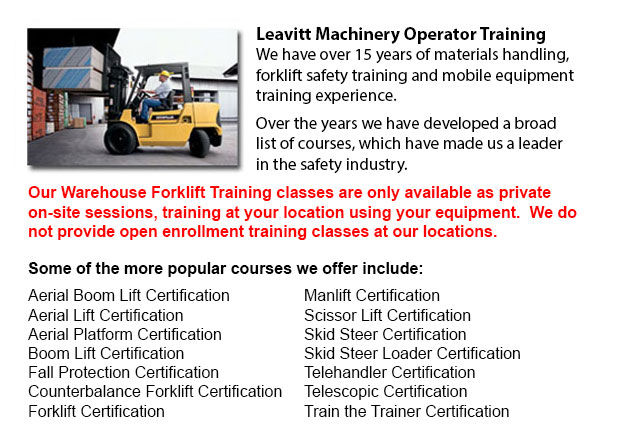
Kelowna Warehouse Forklift Training Programs - Warehouses could either be retail, industrial or commercial facilities, functioning from product distribution services to bulk product retailing. Regardless of the type of warehouse, personnel inside warehouse settings should be well trained in safety measures related to material handling and storage, conveyor systems, loading docks, and pallet jacks and forklifts. Good housekeeping is important to an orderly and safe warehouse environment.
Truck and loading dock systems are usually situated at a height from the ground. Products exit and enter warehouses through these systems where personnel unload and load things from elevated docks and ramps. Particular attention should be paid to safety practice in this stage. To avoid falls, install yellow striping along the edge of docks and ramps. Pay attention to the area all-around delivery trucks that are parked at the loading dock, especially the part between dock and the truck. Be certain that truck wheels are chocked while unloading.
Some warehouses utilize conveyor systems to distribute products within the facility. Conveyor systems have moving belts and wheels that pose a pinch point danger. Keep body parts and hair far away from conveyors to avoid injury. Elevated conveyors pose a danger to staff underneath if safety nets are absent. Personnel ought to know how to stop conveyors in case of emergency. Be aware of the location of emergency stop buttons and off switches. When servicing conveyors, tag out/lock out procedures are mandatory.
Pallet jacks and forklifts are designed to move materials around the warehouse. Operators of forklifts are needed to take training and receive certification. Operators of pallet jacks do not require certification, but should be trained on the machinery. Training programs instruct operators in the proper methods for hoisting materials and moving them to their assigned location. Neither forklifts nor pallet jacks should ever be made use of to lift or transport workers.
Rack system and storage shelving help to create an efficient and orderly work space if they are sturdy, braced, and allow sufficient room for individuals and machines to pass. Careful and slow placement of good is required to avoid accidents caused by products falling off the facing aisle. Aisles should be kept clear by keeping products flat and inside the shelving units. Pallets are made use of for stacking products. They must be in good condition, and palleted products must be baled or shrink-wrapped, whenever possible.
Personal protective equipment (PPE) should be worn, as appropriate, to protect workers' limbs, heads, hands and feet. Bump caps or hard hats, steel-toed shoes and gloves are common PPE.
Slippery floors pocked with dents and pits present a danger. Good housekeeping habits involve keeping warehouse docks and floors clear of debris, oil and dirt. The space should be kept clear of baling supplies, garbage and boxes.
-
Kelowna Forklift Training Program
Kelowna Forklift Training Program - The lift truck is a common powered industrial vehicle which is in wide use these days. They are sometimes called hi los, lift trucks or jitneys. A departments store would use the forklift to unload and load merchan... More -
Kelowna Crane License
Kelowna Crane License - Crane operators ought to be "credentialed", that means they ought to have a crane operator certification or license. Credentialing is considered a mandatory governmental requirement in order to practice as an operator of a cra... More -
Kelowna Boom Lift Safety Training
Kelowna Boom Lift Safey Training - Boom lifts fall under the type of elevated work platform or aerial lifting device. Most usually used in warehousing, construction and industry; the boom lift is so versatile that it could be utilized in almost whate... More -
Kelowna Loader Training
Kelowna Loader Training - Loader Training - Any individual who would like to operate a forklift should take a Loader Training course in order to become a certified forklift truck operator. There are a variety of ways to obtain forklift training. Cour... More -
Kelowna Aerial Lift Safety Training
Kelowna Aerial Lift Safety Training - Each and every year, there are roughly 26 construction deaths attributed to the use of aerial lifts. Most of the craftsmen killed are electrical workers, laborers, painters, ironworkers or carpenters. The majorit... More -
Kelowna Crane Ticket
Kelowna Crane Ticket - Modern cranes can either be simple or complex, based upon the nature of the application they can carry out. For example, mobile cranes are somewhat simple units. A telescopic boom and even a steel truss mounts its movable platf... More -
Kelowna Boom Lift Operator Training
Kelowna Boom Lift Operator Training - The cherry picker work platform is a type of work platform, that will typically have a bucket or platform at the end of a hydraulic lifting system. The machine is likewise referred to as a man lift, boom lift, hy... More -
Kelowna Heavy Equipment Ticket
Kelowna Heavy Equipment Ticket - Depending on the nature of the job at hand, the kind of construction equipment that a heavy equipment operator makes use of differs. Every kind of machine is made to perform particular tasks in the most effective mann... More

Leavitt Operator Training
TOLL FREE: 1-888-254-6157
101-864 McCurdy Place
Kelowna, British Columbia
forkliftcertificationkelowna.com
Email Us
About Us


